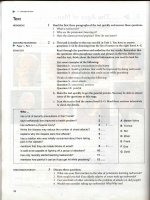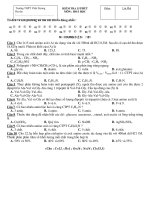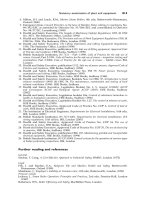Astm e 1036 15
Bạn đang xem bản rút gọn của tài liệu. Xem và tải ngay bản đầy đủ của tài liệu tại đây (157.87 KB, 8 trang )
Designation: E1036 − 15
Standard Test Methods for
Electrical Performance of Nonconcentrator Terrestrial
Photovoltaic Modules and Arrays Using Reference Cells
1
This standard is issued under the fixed designation E1036; the number immediately following the designation indicates the year of
original adoption or, in the case of revision, the year of last revision. A number in parentheses indicates the year of last reapproval. A
superscript epsilon (´) indicates an editorial change since the last revision or reapproval.
1. Scope
E691 Practice for Conducting an Interlaboratory Study to
Determine the Precision of a Test Method
E772 Terminology of Solar Energy Conversion
E927 Specification for Solar Simulation for Photovoltaic
Testing
E941 Test Method for Calibration of Reference Pyranometers With Axis Tilted by the Shading Method (Withdrawn
2005)3
E948 Test Method for Electrical Performance of Photovoltaic Cells Using Reference Cells Under Simulated Sunlight
E973 Test Method for Determination of the Spectral Mismatch Parameter Between a Photovoltaic Device and a
Photovoltaic Reference Cell
E1021 Test Method for Spectral Responsivity Measurements
of Photovoltaic Devices
E1040 Specification for Physical Characteristics of Nonconcentrator Terrestrial Photovoltaic Reference Cells
E1125 Test Method for Calibration of Primary NonConcentrator Terrestrial Photovoltaic Reference Cells Using a Tabular Spectrum
E1362 Test Method for Calibration of Non-Concentrator
Photovoltaic Secondary Reference Cells
E2236 Test Methods for Measurement of Electrical Performance and Spectral Response of Nonconcentrator Multijunction Photovoltaic Cells and Modules
G173 Tables for Reference Solar Spectral Irradiances: Direct
Normal and Hemispherical on 37° Tilted Surface
1.1 These test methods cover the electrical performance of
photovoltaic modules and arrays under natural or simulated
sunlight using a calibrated reference cell.
1.1.1 These test methods allow a reference module to be
used instead of a reference cell provided the reference module
has been calibrated using these test methods against a calibrated reference cell.
1.2 Measurements under a variety of conditions are allowed; results are reported under a select set of reporting
conditions (RC) to facilitate comparison of results.
1.3 These test methods apply only to nonconcentrator terrestrial modules and arrays.
1.4 The performance parameters determined by these test
methods apply only at the time of the test, and imply no past or
future performance level.
1.5 These test methods apply to photovoltaic modules and
arrays that do not contain series-connected photovoltaic multijunction devices; such module and arrays should be tested
according to Test Methods E2236.
1.6 The values stated in SI units are to be regarded as
standard. No other units of measurement are included in this
standard.
1.7 This standard does not purport to address all of the
safety concerns, if any, associated with its use. It is the
responsibility of the user of this standard to establish appropriate safety and health practices and determine the applicability of regulatory limitations prior to use.
3. Terminology
3.1 Definitions—Definitions of terms used in these test
methods may be found in Terminology E772.
3.2 Definitions of Terms Specific to This Standard:
3.2.1 nominal operating cell temperature, NOCT, n—the
temperature of a solar cell inside a module operating at an
ambient temperature of 20°C, an irradiance of 800 Wm−2 , and
an average wind speed of 1 ms−1.
3.2.2 reporting conditions, RC, n—the device temperature,
total irradiance, and reference spectral irradiance conditions
that module or array performance data are corrected to.
2. Referenced Documents
2.1 ASTM Standards:2
1
These test methods are under the jurisdiction of ASTM Committee E44 on
Solar, Geothermal and Other Alternative Energy Sources and are the direct
responsibility of Subcommittee E44.09 on Photovoltaic Electric Power Conversion.
Current edition approved Feb. 1, 2015. Published March 2015. Originally
approved in 1985. Last previous edition approved in 2012 as E1036 – 12. DOI:
10.1520/E1036-15.
2
For referenced ASTM standards, visit the ASTM website, www.astm.org, or
contact ASTM Customer Service at For Annual Book of ASTM
Standards volume information, refer to the standard’s Document Summary page on
the ASTM website.
3
The last approved version of this historical standard is referenced on
www.astm.org.
Copyright © ASTM International, 100 Barr Harbor Drive, PO Box C700, West Conshohocken, PA 19428-2959. United States
1
E1036 − 15
4.3.1 The reference cell is chosen according to the spectral
distribution of the irradiance under which it was calibrated, for
example, the direct normal or global spectrum. These spectra
are defined by Tables G173. The reference cell therefore
determines to which spectrum the test module or array performance is referred.
4.3.2 The reference cell must match the device under test
such that the spectral mismatch parameter is 1.00 6 0.05, as
determined in accordance with Test Method E973.
4.3.3 Recommended physical characteristics of reference
cells are described in Specification E1040.
4.3.4 A reference module may be used instead of a reference
cell throughout these test methods provided 4.3.2 is satisfied
and the short-circuit current of the reference module has been
determined according to the procedures in these test methods
using a reference cell. The reference module must also meet the
module package design requirements in Specification E1040,
with the exception of the electrical connector requirement.
Ideally, electrical connections to an individual cell in the
reference module should be provided to allow for spectral
responsivity measurement according to Test Method E1021.
3.3 Symbols:
3.3.1 The following symbols and units are used in these test
methods:
αr—temperature coefficient of reference cell ISC, °C−1,
α—current temperature coefficient of device under test,
°C−1,
β(E)—voltage temperature function of device under test,
°C−1,
C—calibration constant of reference cell, Am2W−1,
C'—adjusted calibration constant of reference cell, Am2W−1,
Cf—NOCT Correction factor,°C,
δ(T)—voltage irradiance correction function of device under
test, dimensionless,
∆T—NOCT cell-ambient temperature difference, °C,
E—irradiance, Wm−2,
Eo—irradiance at RC, Wm−2,
FF—fill factor, dimensionless,
I—current, A,
Imp—current at maximum power, A,
Io—current at RC, A,
Ir—short-circuit current of reference cell (or module, see
1.1.1 and 4.3.4), A,
Isc—short-circuit current, A,
M—spectral mismatch parameter, dimensionless,
P—electrical power, W,
Pm—maximum power, W,
T—temperature, °C,
Ta—ambient temperature, °C,
Tc—temperature of cell in module, °C,
To—temperature at RC, °C,
Tr—temperature of reference cell, °C,
ν—wind speed, ms−1,
V—voltage, V,
Vmp—voltage at maximum power, V,
Vo—voltage at RC, V, and
Voc—open-circuit voltage, V.
4.4 The spectral response of the module or array is usually
taken to be that of a representative cell from the module or
array tested in accordance with Test Method E1021. The
representative cell should be packaged such that the optical
properties of the module or array packaging and the representative cell package are similar.
4.5 The tests are performed using either natural or simulated
sunlight. Solar simulation requirements are stated in Specification E927.
4.5.1 If a pulsed solar simulator is used as a light source, the
transient responses of the module or array and the reference
cell must be compatible with the test equipment.
4.6 The data from the measurements are translated to a set
of reporting conditions (see 5.3) selected by the user of these
test methods. The actual test conditions, the test data (if
available), and the translated data are then reported.
4. Summary of Test Methods
4.1 Measurement of the performance of a photovoltaic
module or array illuminated by a light source consists of
determining at least the following electrical characteristics:
short-circuit current, open-circuit voltage, maximum power,
and voltage at maximum power.
5. Significance and Use
5.1 It is the intent of these procedures to provide recognized
methods for testing and reporting the electrical performance of
photovoltaic modules and arrays.
4.2 These parameters are derived by applying the procedure
in Section 8 to a set of current-voltage data pairs (I-V data)
recorded with the test module or array operating in the
power-producing quadrant.
5.2 The test results may be used for comparison of different
modules or arrays among a group of similar items that might be
encountered in testing a group of modules or arrays from a
single source. They also may be used to compare diverse
designs, such as products from different manufacturers. Repeated measurements of the same module or array may be used
for the study of changes in device performance.
TABLE 1 Reporting Conditions
Standard reporting conditions
Nominal operating conditions
Total Irradiance,
Wm−2
Spectral
Irradiance
1000
800
G173
...
Device
Temperature,
°C
25
NOCT
5.3 Measurements may be made over a range of test
conditions. The measurement data are numerically translated
from the test conditions to standard RC, to nominal operating
conditions, or to optional user-specified reporting conditions.
Recommended RC are defined in Table 1.
5.3.1 If the test conditions are such that the device temperature is within 62°C of the RC temperature and the total
irradiance is within 65 % of the RC irradiance, the numerical
4.3 Testing the performance of a photovoltaic device involves the use of a calibrated photovoltaic reference cell to
determine the total irradiance.
2
E1036 − 15
6.1.3 Reference cells may be calibrated in accordance with
Test Methods E1125 or E1362, as appropriate for a particular
application.
6.1.4 A current measurement instrument (see 6.7) shall be
used to determine the Isc of the reference cell when illuminated
with the light source (see 6.4).
translation consists of a correction to the measured device
current based on the total irradiance during the I-V measurement.
5.3.2 If the provision in 5.3.1 is not met, performance at RC
is obtained from four separate I-V measurements at temperature and irradiance conditions that bracket the desired RC using
a bilinear interpolation method.4
5.3.2.1 There are a variety of methods that may be used to
bracket the temperature and irradiance. One method involves
cooling the module under test below the reference temperature
and making repeated measurements of the I-V characteristics as
the module warms up. The irradiance of pulsed light sources
may be adjusted by using neutral density mesh filters of
varying transmittance. If the distance between the simulator
and the test plane can be varied then this adjustment can be
used to change the irradiance. In natural sunlight, the irradiance
will change with the time of day or if the solar incidence angle
is adjusted.
6.2 Test Fixture— The device to be tested is mounted on a
test fixture that facilitates temperature measurement and fourwire current-voltage measurements (Kelvin probe, see 6.3).
The design of the test fixture shall prevent any increase or
decrease of the device output due to reflections or shadowing.
Arrays installed in the field shall be tested as installed. See
7.2.3 for additional restrictions and reporting requirements.
6.3 Kelvin Probe— An arrangement of contacts that consists
of two pairs of wires attached to the two output terminals of the
device under test. One pair of wires is used to conduct the
current flowing through the device, and the other pair is used to
measure the voltage across the device. A schematic diagram of
an I-V measurement using a Kelvin Probe is given in Fig. 1 of
Test Method E948.
5.4 These test methods are based on two requirements.
5.4.1 First, the reference cell (or module, see 1.1.1 and
4.3.4) is selected so that its spectral response is considered to
be close to the module or array to be tested.
5.4.2 Second, the spectral response of a representative cell
and the spectral distribution of the irradiance source must be
known. The calibration constant of the reference cell is then
corrected to account for the difference between the actual and
the reference spectral irradiance distributions using the spectral
mismatch parameter, which is defined in Test Method E973.
6.4 Light Source— The light source shall be either natural
sunlight or a solar simulator providing Class A, B, or C
simulation as specified in Specification E927.
6.5 Temperature Measurement Equipment—The instrument
or instruments used to measure the temperature of both the
reference cell and the device under test shall have a resolution
of at least 0.1°C, and shall have a total error of less than 61°C
of reading.
6.5.1 Temperature sensors, such as thermocouples or
thermistors, suitable for the test temperature range shall be
attached in a manner that allows measurement of the device
temperature. Because module and array temperatures can vary
spatially under continuous illumination, multiple sensors distributed over the device should be used, and the results
averaged to obtain the device temperature.
6.5.2 When testing modules or arrays for which direct
measurement of the cell temperature inside the package is not
feasible, sensors can be attached to the rear side of the devices.
The error due to temperature gradients will depend on the
thermal characteristics of the packaging, especially under
continuous illumination. Modules with glass back sheets will
have higher gradients than modules with thin polymer backs,
for example.
5.5 Terrestrial reference cells are calibrated with respect to
a reference spectral irradiance distribution, for example, Tables
G173.
5.6 A reference cell made and calibrated as described in 4.3
will indicate the total irradiance incident on a module or array
whose spectral response is close to that of the reference cell.
5.7 With the performance data determined in accordance
with these test methods, it becomes possible to predict module
or array performance from measurements under any test light
source in terms of any reference spectral irradiance distribution.
5.8 The reference conditions of 5.3.1 must be met if the
measured I-V curve exhibits “kinks” or multiple inflection
points.
6. Apparatus
6.6 Variable Load— An electronic load, such as a variable
resistor, a programmable power supply, or a capacitive sweep
circuit, used to operate the device to be tested at different
points along its I-V characteristic.
6.6.1 The variable load should be capable of operating the
device to be tested at an I-V point where the voltage is within
1 % of Voc in the power-producing quadrant.
6.6.2 The variable load should be capable of operating the
device to be tested at an I-V point where the current is within
1 % of Isc in the power-producing quadrant.
6.6.3 The variable load should allow the device output
power (the product of device current and device voltage) to be
varied in increments as small as 0.2 % of the maximum power.
6.1 Photovoltaic Reference Cell—A calibrated reference cell
is used to determine the total irradiance during the electrical
performance measurement.
6.1.1 The reference cell shall be matched in its spectral
response to a representative cell of the test module or array
such that the spectral mismatch parameter as determined by
Test Method E973 is 1.00 6 0.05.
6.1.2 Specification E1040 provides recommended physical
characteristics of reference cells.
4
Marion, B., Rummel, S., and Anderberg, A., “Current-Voltage Curve Translation by Bilinear Interpolation,” Prog. Photovolt: Res. Appl. 2004, 12:593–607.
3
E1036 − 15
7.2.3 Mount the reference cell and the device to be tested in
the test fixture coplanar within 62°, and normal to the
illumination source within 610°. If an array or module cannot
be aligned to within 610°, the solar angle of incidence, the
device orientation and its tilt angle must be reported with the
data.
7.2.4 Connect the four-wire Kelvin probe to the module or
array output terminals.
7.2.5 Expose the test device to the illumination source for a
period of time sufficient for the device to achieve thermal
equilibrium.
7.2.6 If the temporal instability of the light source (as
defined in Specification E927) is less than 0.1 %, the total
irradiance may be determined with the reference cell prior to
the performance measurement. In this case, measure the
short-circuit current of the reference cell, Ir.
7.2.7 Obtain the average temperature, Tc, of a cell in the
module or array using one of the following two methods:
7.2.7.1 For outdoor measurements in natural sunlight if the
NOCT correction factors are known (see Annex A1), measure
the ambient air temperature and the wind speed. The average
wind speed for 5 min preceding the test and during the test
should not exceed 1.75 ms−1.
7.2.7.2 Measure the temperature of the sensors, following
the provisions of 6.5.
7.2.8 Measure the reference cell temperature, Tr.
7.2.9 Measure the I-V characteristic of the test device by
changing the operating point with the variable load so that the
provisions of 6.6 are met. At each operating point along the I-V
characteristic, measure the device voltage, the device current,
and Ir.
7.2.9.1 If the provision of 7.2.6 is met, it is not necessary to
measure Ir at each operating point.
7.2.10 Immediately following the I-V recording, repeat the
temperature measurements and verify that temperature changes
during the test were less than 2°C.
7.3 If the provision of 5.3.1 is not met, repeat 7.1 or 7.2
three times to obtain a total of four I-V characteristics as
required by 5.3.2.
6.6.4 The electrical response time of the variable load
should be fast enough to sweep the required range of I-V
operating points during the measurement period. It is possible
that the response time of the device under test may limit how
fast the range of I-V points can be swept, especially when
pulsed simulators are used. For these cases, it may be necessary
to make multiple measurements over smaller portions of the
I-V curve to obtain the entire recommended range.
6.7 Current Measurement Equipment—The instrument or
instruments used to measure the current through the device
under test and the Isc of the reference cell shall have a
resolution of at least 0.05 % of the maximum current
encountered, and shall have a total error of less than 0.2 % of
the maximum current encountered.
6.8 Voltage Measurement Equipment—The instrument or
instruments used to measure the voltage across the device
under test shall have a resolution of at least 0.05 % of the
maximum voltage encountered, and shall have a total error of
less than 0.2 % of the maximum voltage encountered.
7. Procedures
7.1 Momentary Illumination Technique:
7.1.1 This technique is valid for use with pulsed solar
simulators, shuttered continuous solar simulators, or shuttered
sunlight. For testing under continuous illumination see 7.2.
7.1.2 Determine the spectral mismatch parameter, M, using
Test Method E973.
7.1.3 Mount the reference cell and the device to be tested in
the test fixture coplanar within 62°, and normal to the
illumination source within 610°. If an array or module cannot
be aligned to within 610°, the solar angle of incidence, the
device orientation and its tilt angle must be reported with the
data.
7.1.4 Connect the four-wire Kelvin probe to the module or
array output terminals.
7.1.5 Expose the module or array to the light source.
7.1.6 If the temporal instability of the light source (as
defined in Specification E927) is less than 0.1 %, the total
irradiance may be determined with the reference cell prior to
the performance measurement. In this case, measure the
short-circuit current of the reference cell, Ir.
7.1.7 Measure the I-V characteristic of the test device by
changing the operating point with the variable load so that the
provisions of 6.6 are met. At each operating point along the I-V
characteristic, measure the device voltage, the device current,
and Ir.
7.1.7.1 If the provision of 7.1.6 is met, it is not necessary to
measure Ir at each operating point.
7.1.8 Measure the temperature of the reference cell, Tr, and
the temperature of the test device, Tc. Temperature changes
during the test shall be less than 2°C.
8. Calculation of Results
8.1 Adjust the reference cell calibration constant using:
C' 5
C
11α r ~ T r 2 T o ! #
M @
(1)
8.2 Calculate the total irradiance during the performance
measurement(s) using the following equation (if Ir was measured at each operating point, use the average value of Ir):
E5
Ir
C'
(2)
8.3 If the provision in 5.3.1 is met, correct the current at
each point of the I-V data for irradiance using the following
equation:
7.2 Continuous Illumination Technique:
7.2.1 This technique is valid for testing in continuous solar
simulators or natural sunlight.
7.2.2 Determine the spectral mismatch parameter, M, using
Test Method E973.
I 5 Im
Eo
E
(3)
8.4 If the provision in 5.3 is not met, use the bilinear
interpolation method specified in 5.3.2 to calculate the I-V
characteristic at RC using the four I-V curves obtained in 7.3.
4
E1036 − 15
8.5 Determine the short-circuit current, Isc, from the I-V data
using one of the following procedures:
8.5.1 If an I-V data pair exists where V is 0.0 6 0.005 Voc,
I from this pair may be considered to be the short-circuit
current.
8.5.2 If the condition in 8.5.1 is not met, calculate the
short-circuit current from several I-V data pairs where V is
closest to zero using linear interpolation or extrapolation.
FF 5
9.1 The end user ultimately determines the amount of
information to be reported. Listed below are the minimum
mandatory reporting requirements.
9.2 Test Module or Array Description:
9.2.1 Identification,
9.2.2 Physical description,
9.2.3 Area,
9.2.4 Voltage temperature functions, if known,
9.2.5 Current temperature functions, if known,
9.2.6 Voltage irradiance functions coefficient, if known,
9.2.7 Spectral response of the representative cell, in plotted
or tabular form, as required for Test Methods E1021, and
9.2.8 NOCT, Cf, and ∆T functional dependence, if known.
8.7 If the provision in 5.3.1 is not met, use the bilinear
interpolation method specified in 5.3.2 to calculate the I-V
characteristic at RC.
9.3 Reference Cell (or Module, see 1.1.1 and 4.3.4) Description:
9.3.1 Identification,
9.3.2 Physical description,
9.3.3 Calibration laboratory,
9.3.4 Calibration procedure (see 6.1.3),
9.3.5 Date of calibration,
9.3.6 Reference spectral irradiance distribution (see 4.3.1),
9.3.7 Spectral response, in plotted or tabular form, as
required for Test Methods E1021, and
9.3.8 Calibration constant.
9.3.9 Uncertainty of calibration.
8.8 Form a table of P versus Vo values by multiplying Io by
Vo.
8.9 Find the maximum power point Pm, and the corresponding Vmp, in the P versus Vo table. Because of random
fluctuations and the probability that one point in the tabular
Io-Vo data will not be exactly on the maximum power point, it
is recommended that the following procedure be used to
calculate the maximum power point, especially for devices
with fill factors greater than 80 %.
8.9.1 Perform a fourth-order polynomial least-squares fit to
the P versus Vo data that are within the following limits:
(4)
0.75V mp # V o # 1.15V mp
(5)
(6)
9. Report
8.6 Determine the open-circuit voltage, Voc, from the I-V
data measured in Section 7 using one of the following
procedures:
8.6.1 If an I-V data pair exists where I is 0.0 6 0.001 Isc, V
from this pair may be considered to be the open-circuit voltage.
8.6.2 If the condition in 8.6.1 is not met, calculate the
open-circuit voltage from several I-V data pairs where I is
closest to zero using linear interpolation or extrapolation.
0.751mp # I o # 1.15I mp
Pm
V ocI sc
9.4 Test Conditions:
9.4.1 Reporting conditions,
9.4.2 Description and classification of light source (for solar
simulators) or ambient temperature, wind speed, solar incidence angle, and geographical location (for outdoor
measurements),
9.4.3 Date and time of test,
9.4.4 Spectral mismatch parameter,
9.4.5 Irradiance,
9.4.5.1 Average irradiance measured with reference cell if
5.3.1 is met, or
9.4.5.2 The four average irradiance measured for the bilinear interpolation.
9.4.6 Device temperature,
9.4.6.1 Tc, if the provision in 5.3.1 is met, or
9.4.6.2 The four temperatures measured for the bilinear
interpolation.
and:
These limits are guidelines that have been found to be useful
for this procedure and need not be followed precisely. This
results in a polynomial representation of P as a function of Vo.
8.9.1.1 It is recommended that a plot of the Io-Vo data and
the polynomial fit be made to visually assess the reliability of
the fit.
8.9.1.2 Fewer data points used for the polynomial fit may
require the polynomial order to be reduced.
8.9.2 Calculate the derivative polynomial of the polynomial
obtained from 8.9.1.
8.9.3 Find a root of the derivative polynomial obtained from
8.9.2 using Vmp as an initial guess. An appropriate numerical
procedure is the Newton-Horner method with deflation.5 This
root now becomes Vmp.
8.9.4 Calculate Pm by substituting the new Vmp into the
original polynomial from 8.9.1.
9.5 Test Results:
9.5.1 Short-circuit current,
9.5.2 Open-circuit voltage,
9.5.3 Maximum power,
9.5.4 Voltage at maximum power,
9.5.5 Fill factor, and
9.5.6 Tabulated and plotted Io-Vo data.
8.10 Calculate the fill factor, FF, using the following
equation:
10. Precision and Bias
10.1 Interlaboratory Test Program—An interlaboratory
study of module performance measurements was conducted in
5
Burden, R. L., and Faires, J. D., Numerical Analysis , 3rd ed., Prindle, Weber
& Schmidt, Boston, MA, 1985, p. 42 ff.
5
E1036 − 15
percent, while bias from the three sources listed here can be as
much as ten times greater if the bias is not minimized.
10.4.2 Another source of bias can be hysteresis in the I-V
data caused by rapid sweeping through the I-V curve. This
effect, which can result in a value for the maximum power that
is either too high or too low, is especially evident in pulsed
solar simulator systems.
10.4.3 Loading of the reference cell by the current measurement equipment, that is, non-zero input impedance, can result
in measured values of irradiance that are too small. The
magnitude of this error will depend on the voltage across the
reference cell during the measurements, and the slope of its I-V
curve near the short-circuit current point.
10.4.4 Measurement of the cell temperature at the back of
the device can give a value that is lower than the junction
temperature during exposure of the module to the test irradiation. This may result in a value for the voltage slightly too low
when translated to RC.
10.4.5 Angular misalignment between the reference cell and
the device under test can introduce a bias error. As the angle of
incidence of the light source increases, the error due to
misalignment increases. The magnitude of this error is equal to
the percent difference between cos(θi) and cos(θi + θe), where
θi is the angle of incidence and θe is the misalignment angle. If
the limits specified in 7.1.3 and 7.2.3 are met, the maximum
error is 0.7 %.
1992 through 1994. Seven laboratories performed three repetitions on each of six modules circulated among the participants.
The design of the experiment, similar to that of Practice E691,
and a within-between analysis of the data are given in ASTM
Research Report No. RR:E44 – 1005.
10.2 Test Result— Because I-V measurements produce a
table of current versus voltage points rather than a single
numeric result, the precision analysis was performed on the
maximum power point data submitted by the participants. The
precision information given below is in percentage points of
the maximum power in watts.
10.3 Precision:
95 % repeatability limit (within laboratory)
95 % reproducibility limit (between laboratory)
0.7 %
6.7 %
10.4 Bias—The contribution of bias to the total error will
depend upon the bias of each individual parameter used for the
determination of the device performance.
10.4.1 It has been shown that the total bias tends to be
dominated by three sources: the reference cell calibration, the
spatial uniformity of the light source, and, for efficiency
determinations, the area measurement.6 Bias contributions
from instrumentation tend to be, at most, a few tenths of a
6
Emery, K. A., Osterwald, C. R., and Wells, C. V., ''Uncertainty Analysis of
Photovoltaic Efficiency Measurements,” Proceedings of the 19th IEEE Photovoltaics Specialists Conference—1987, Institute of Electrical and Electronics Engineers,
New York, NY, 1987, pp. 153–159.
11. Keywords
11.1 arrays; modules; performance; photovoltaic; testing
ANNEX
(Mandatory Information)
A1. METHOD OF DETERMINING THE NOMINAL OPERATING CELL TEMPERATURE (NOCT) OF AN ARRAY OR MODULE
a function of E should approximate a straight line. The data can
be linearly regressed to obtain a slope and intercept equation of
the form:
A1.1 Commentary
A1.1.1 The temperature of a solar cell, Tc, is primarily a
function of the air temperature, Ta, the average wind velocity,
ν, the configuration of the module mounting, and the total solar
irradiance, E, impinging on the active side of the device.
NOCT is defined as the temperature of a device at the
conditions of the Nominal Terrestrial Environmental (NTE):
Air temperature
Average wind speed
Additional conditions are:
Irradiance
Mounting
Electrical load
~ T c 2 T a ! 5 m·E1b
(A1.1)
where:
m = the slope, and
b = the ∆ T intercept.
Setting E = 800 Wm−2 and Ta = 20°C in this equation, and
solving for Tc will yield an uncorrected NOCT value:
Ta = 20°C
ν = 1 ms−1
E = 800 Wm−2
oriented normal to solar noon, back
either open or closed
open circuit
T c 5 NOCT 5 m· ~ 800 Wm22 ! 1b1 ~ 20°C !
(A1.2)
A1.1.3 This uncorrected NOCT value is then corrected for
wind speed in accordance with Fig. A1.1 to yield the final
NOCT value.
A1.1.2 The approach for determining NOCT is based on the
fact that the temperature difference (Tc − Ta) = ∆T is largely
independent of air temperature and is essentially linearly
proportional to the irradiance level. Therefore, a graph of ∆T as
A1.1.4 The NOCT test procedure is based on measuring Tc
through temperature sensors attached directly to the individual
6
E1036 − 15
A1.3.3 Locate the wind transducer at the approximate
height of the module and as near to one of the sides of the
module as feasible.
A1.3.4 For ambient air temperature measurement, the temperature sensor must be located at the approximate height of
the module. The measurement is made in the shadow of the
module.
A1.3.5 For cell temperature measurement, the sensor probes
are directly attached to the back of the monitored cells. At least
one cell in each quadrant of the module must be measured.
Ensure that these cells are not operating in reverse bias.
A1.3.6 Ensure there are no obstructions to prevent full
irradiation of the module for a period beginning a minimum of
4 h before and 4 h after solar noon. The ground surrounding the
module must not have a high solar reflectance and should be
flat or sloping, or both, away from the test fixture. Grass and
various types of ground covers, blacktop, and dirt are recommended for the local surrounding area. Buildings having highly
reflective surfaces should not be present in the immediate
vicinity. Good engineering judgment shall be exercised to
ensure that the module front and back sides are receiving a
minimum of reflected solar energy from the surrounding area.
A1.3.7 The wind must be predominantly either northerly or
southerly; flow parallel to the plane of the array is not
acceptable and can result in a low value of NOCT.
FIG. A1.1 NOCT Correction Factor
A1.3.8 The module terminals are left in an open-circuit
condition.
cells in the module over a range of environmental conditions
similar to the NTE. The device is tested in a rack so as to
simulate use conditions. A plot of ∆T versus E is obtained from
a minimum of two field tests in accordance with the following
test procedure.
A1.3.9 Clean the active side of the module and the pyranometer bulb before the start of each test. Dirt must not be
allowed to build up during the measurement. Cleaning with
mild soap solution followed by a rinse with distilled water has
proven to be effective.
A1.2 Apparatus
A1.3.10 A calibration check should be made for all the
equipment prior to the start of the test.
A1.2.1 Pyranometer— A reference pyranometer, as defined
by Test Method E941.
A1.4 Procedure
A1.2.2 Wind Transducer— Records both the wind direction
and the wind speed.
A1.4.1 Acquire a semicontinuous record of ∆T over a oneor two-day period. In addition, irradiance, wind speed, wind
direction, and air temperature must be continuously recorded.
Record all data approximately every 5 min. Acceptable data
consists of measurements made when the average wind speed
is 1.0 6 0.75 ms−1 and with gusts less than 4 ms−1 for a period
of 5 min prior and up to the time of measurement. Local air
temperature during the test period shall be 20 6 15°C.
A1.2.3 Temperature Sensors—Record air and cell temperatures to within 61°C.
A1.2.4 Mountings—The device must be mounted in a manner similar to the application in which it is to be used, including
exposure to or isolation from the wind.
A1.2.5 Data Recording Equipment—The response time and
scale ranges shall be compatible with the transducers being
used.
A1.4.2 Construct a plot from a set of measurements made
either prior to solar noon or after solar noon that defines the
relationship between ∆T and E.
A1.3 Preparation
A1.4.3 Using the plot of ∆T versus E, the value of ∆T at the
NTE is determined by interpolating the average value of ∆T for
E = 800 Wm−2. Use Eq A1.1 to interpolate.
A1.3.1 Locate the module to be tested in the interior of a
subarray. Black aluminum panels or other modules of the same
design must be used to fill in any remaining open area of the
subarray structure. Position the plane of the module so that it is
normal to the sun within 65° at solar noon.
A1.4.4 A correction factor, Cf, to the uncorrected NOCT for
average air temperature and wind velocity is determined from
Fig. A1.1. This value is added to the uncorrected NOCT and
corrects the data to 20°C and 1 ms−1.
A1.3.2 Mount the pyranometer in the same plane as the
module and in close proximity to the test module.
7
E1036 − 15
ASTM International takes no position respecting the validity of any patent rights asserted in connection with any item mentioned
in this standard. Users of this standard are expressly advised that determination of the validity of any such patent rights, and the risk
of infringement of such rights, are entirely their own responsibility.
This standard is subject to revision at any time by the responsible technical committee and must be reviewed every five years and
if not revised, either reapproved or withdrawn. Your comments are invited either for revision of this standard or for additional standards
and should be addressed to ASTM International Headquarters. Your comments will receive careful consideration at a meeting of the
responsible technical committee, which you may attend. If you feel that your comments have not received a fair hearing you should
make your views known to the ASTM Committee on Standards, at the address shown below.
This standard is copyrighted by ASTM International, 100 Barr Harbor Drive, PO Box C700, West Conshohocken, PA 19428-2959,
United States. Individual reprints (single or multiple copies) of this standard may be obtained by contacting ASTM at the above
address or at 610-832-9585 (phone), 610-832-9555 (fax), or (e-mail); or through the ASTM website
(www.astm.org). Permission rights to photocopy the standard may also be secured from the Copyright Clearance Center, 222
Rosewood Drive, Danvers, MA 01923, Tel: (978) 646-2600; />
8









